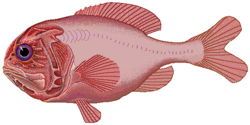
Back سمك خشن برتقالى ARZ Hoplostethus atlanticus CEB Hoplostethus atlanticus German Hoplostethus atlanticus Spanish Erloju-arrain laranja Basque Búrfiskur Faeroese Hoplostèthe orange French Hoplostethus atlanticus Irish Sembeliak merah ID Búrfiskur Icelandic
| Orange roughy | |
|---|---|

| |

| |
| Scientific classification | |
| Domain: | Eukaryota |
| Kingdom: | Animalia |
| Phylum: | Chordata |
| Class: | Actinopterygii |
| Order: | Trachichthyiformes |
| Family: | Trachichthyidae |
| Genus: | Hoplostethus |
| Species: | H. atlanticus
|
| Binomial name | |
| Hoplostethus atlanticus Collett, 1889
| |
The orange roughy (Hoplostethus atlanticus), also known as the red roughy, slimehead and deep sea perch, is a relatively large deep-sea fish belonging to the slimehead family (Trachichthyidae). It is bathypelagic, found in cold (3 to 9 °C or 37 to 48 °F), deep (180-to-1,800-metre or 590-to-5,910-foot) waters of the Western Pacific Ocean, eastern Atlantic Ocean (from Iceland to Morocco; and from Walvis Bay, Namibia, to off Durban, South Africa), Indo-Pacific (off New Zealand and Australia), and in the eastern Pacific off Chile. The orange roughy is notable for its extraordinary lifespan, attaining over 200 years. The fish has a bright, brick red color, fading to a yellowish-orange after death.
Like other slimeheads, orange roughy is slow-growing and late to mature, resulting in a very low stock resilience, making them extremely susceptible to overfishing. Despite this, the species is important to commercial deep-trawl fisheries; many stocks (especially those off New Zealand and Australia, which were first exploited in the late 1970s), became severely depleted within 3–20 years, but several have subsequently recovered to levels that fisheries management believe are sustainable, although substantially below unfished populations. The UK Marine Conservation Society has categorized orange roughy as "vulnerable to exploitation".
- ^ Collette, B.; Fernandes, P.; Heessen, H.; Herrera, J.; Smith-Vaniz, W.F. (2015). "Hoplostethus atlanticus (Europe assessment)". IUCN Red List of Threatened Species. 2015: e.T155168A45884209. Retrieved 4 May 2024.
© MMXXIII Rich X Search. We shall prevail. All rights reserved. Rich X Search
